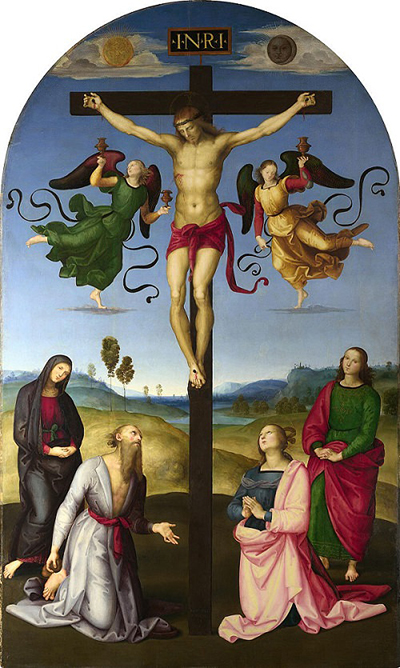The Mond Crucifixion by Raphael is an early work that was influenced by Perugino.
The painting was originally an altarpiece for San Domenico church in Città di Castello and depicts Jesus on the cross with 6 other figures. Even though he's dying, Christ looks peaceful. There are two angles daintily collecting his blood using chalices; since the piece used to be an altarpiece, then the Catholic doctrine of transubstantiation proposes that the blood is the same one that is used for the Holy Communion (Eucharist). The two angels are standing on clouds, which gives the sky an ethereal atmosphere, and the moon and sun at the top of this picture bring earth and heaven together.
Mary is standing on the right side of Christ with a look of sadness on her face. John the Evangelist, looking somewhat feminine as always, is gazing out at viewers from Jesus' left. Mary Magdelene and St Jerome are kneeling at the base of the cross. The praying hands of Mary offset the open palm of Jerome, exemplifying Jerome offering himself up as the servant of Christ while acknowledging Christ's sacrifice. In Jerome's other hand, he is holding the rock that he used to hit his chest after succumbing to sinful thoughts when he was a hermit. Ludwig Mond bequeathed the painting to the National Gallery.
Art can make something that is terrible to appear beautiful. This ability is also seen in Mond Crucifixion. The painting has neglected the pain and suffering that Christ endured on the cross. Jesus is shown unblemished and peaceful, except for his wounds in feet, hands and side. Raphael highlights Christ perfection to remain true to the High Renaissance painting style. The atmospheric perspective plus landscape exhibit Raphael's Peruginesque style. Rather than focusing on the painful and gruesome nature of Christ's death, it strengthens the doctrine of transubstantiation, serving as a symbolic blood representation for the Eucharist.
Mond Crucifixion by Raphael was analysed in the London-based art museum, National Gallery, and the typical Renaissance period pigments were identified. Raphael painted the Mond Crucifixion among other pigments with ochres, vermilion, verdigris, lead-tin-yellow and natural ultramarine. The red colour has a strong significance. Every figure in the painting has a touch of red. All the figures are pictorially touched, and they are redeemed by Christ blood. Also, other colours connect the elements of the painting. There are colours in the picture's that have been repeated in its bottom half. For instance, the blue colour of the sky has been picked up in the clothes St Jerome is wearing and the green colour on the clothes one of the two angels is wearing is in St John’s garments as well.
Also, the gold colour on the second angel's garments is seen in the hills and the sun and lights up Mary Magdalene's cloak, who radiates the light reflected from the sun and the Son whose unconditional love changed her life. Additionally, the red colour (colour of the flesh) seen on all the figures in the picture binds them to Christ's blood whose flesh is dominating the centre of the painting.




